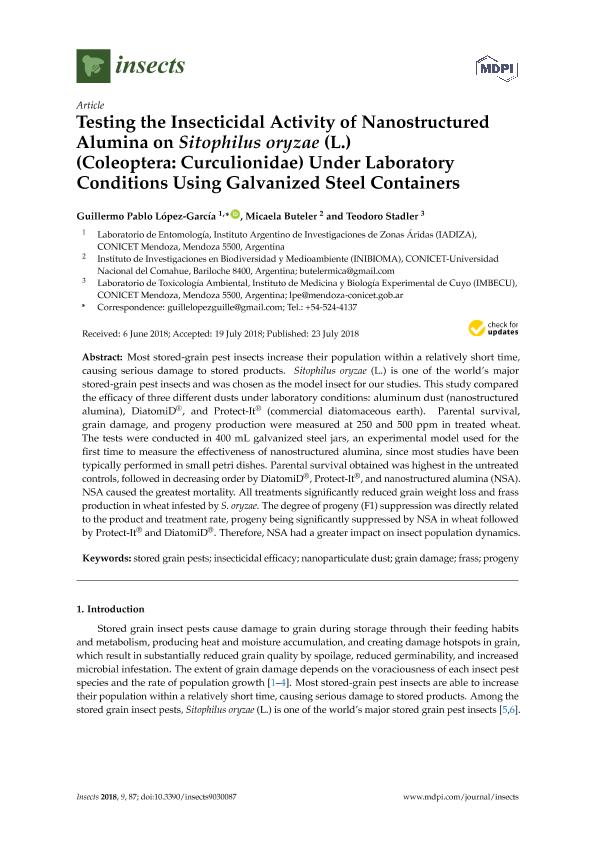Artículo
Testing the insecticidal activity of nanostructured alumina on sitophilus oryzae (L.) (coleoptera: Curculionidae) under laboratory conditions using galvanized steel containers
Fecha de publicación:
09/2018
Editorial:
MDPI
Revista:
Insects
ISSN:
2075-4450
Idioma:
Inglés
Tipo de recurso:
Artículo publicado
Clasificación temática:
Resumen
Most stored-grain pest insects increase their population within a relatively short time, causing serious damage to stored products. Sitophilus oryzae (L.) is one of the world’s major stored-grain pest insects and was chosen as the model insect for our studies. This study compared the efficacy of three different dusts under laboratory conditions: aluminum dust (nanostructured alumina), DiatomiD®, and Protect-It® (commercial diatomaceous earth). Parental survival, grain damage, and progeny production were measured at 250 and 500 ppm in treated wheat. The tests were conducted in 400 mL galvanized steel jars, an experimental model used for the first time to measure the effectiveness of nanostructured alumina, since most studies have been typically performed in small petri dishes. Parental survival obtained was highest in the untreated controls, followed in decreasing order by DiatomiD®, Protect-It®, and nanostructured alumina (NSA). NSA caused the greatest mortality. All treatments significantly reduced grain weight loss and frass production in wheat infested by S. oryzae. The degree of progeny (F1) suppression was directly related to the product and treatment rate, progeny being significantly suppressed by NSA in wheat followed by Protect-It® and DiatomiD®. Therefore, NSA had a greater impact on insect population dynamics.
Archivos asociados
Licencia
Identificadores
Colecciones
Articulos(IADIZA)
Articulos de INST. ARG DE INVEST. DE LAS ZONAS ARIDAS
Articulos de INST. ARG DE INVEST. DE LAS ZONAS ARIDAS
Articulos(IMBECU)
Articulos de INST. DE MEDICINA Y BIO. EXP. DE CUYO
Articulos de INST. DE MEDICINA Y BIO. EXP. DE CUYO
Articulos(INIBIOMA)
Articulos de INST. DE INVEST.EN BIODIVERSIDAD Y MEDIOAMBIENTE
Articulos de INST. DE INVEST.EN BIODIVERSIDAD Y MEDIOAMBIENTE
Citación
López García, Guillermo Pablo; Buteler, Micaela; Stadler, Teodoro; Testing the insecticidal activity of nanostructured alumina on sitophilus oryzae (L.) (coleoptera: Curculionidae) under laboratory conditions using galvanized steel containers; MDPI; Insects; 9; 87; 9-2018; 1-9
Compartir
Altmétricas




